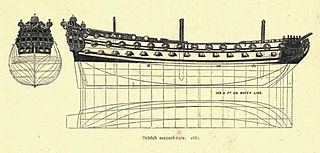
The M29 class comprised five monitors of the Royal Navy, all built and launched during 1915.

In the rating system of the Royal Navy used to categorise sailing warships, a second-rate was a ship of the line which by the start of the 18th century mounted 90 to 98 guns on three gun decks; earlier 17th-century second rates had fewer guns and were originally two-deckers or had only partially armed third gun decks.

HMS Cornwall was a 74-gun third-rate Vengeur-class ship of the line built for the Royal Navy in the 1810s. She spent most of her service in reserve and was converted into a reformatory and a school ship in her later years. The ship was broken up in 1875.

The Abercrombie class of monitors served in the Royal Navy during the First World War.

The Erebus class of warships was a class of 20th century Royal Navy monitors armed with a main battery of two 15-inch /42 Mk 1 guns in a single turret. It consisted of two vessels, Erebus and Terror. Both were launched in 1916 and saw active service in World War I off the Belgian coast. After being placed in reserve between the wars, they served in World War II, with Terror being lost in 1941 and Erebus surviving to be scrapped in 1946.

The Lord Clive-class monitor, sometimes referred to as the General Wolfe class, were ships designed for shore bombardment and were constructed for the Royal Navy during the First World War.

The Marshal Ney class was a class of monitor built for the Royal Navy during the First World War.

The Humber-class monitors were three large gunboats under construction for the Brazilian Navy in Britain in 1913. Designed for service on the Amazon River, the ships were of shallow draft and heavy armament and were ideally suited to inshore, riverine and coastal work but unsuitable for service at sea, where their weight and light draft reduced their speed from a projected twelve knots to under four. The class comprised Humber, Mersey and Severn. All three were taken over by the Royal Navy shortly before the outbreak of the First World War and were commissioned as small monitors. All three saw extensive service during the war and were sold in 1919.
HMS Falmouth was a 50-gun fourth-rate ship of the line built for the Royal Navy in the first decade of the 18th century. The ship participated in several battles during the War of the Spanish Succession (1701–15) and the War of Jenkins' Ear (1739–48).

The Gueydon-class cruiser was a three-ship class of armored cruisers built in the first decade of the twentieth century for the French Navy.
Tsesarevich was a wooden-hulled, steam-powered, first-rate ship of the line built for the Imperial Russian Navy in the mid-1850s. Intended to serve with the Black Sea Fleet, she was transferred to the Baltic Fleet before her engine was installed in accordance with the terms of the Treaty of Paris that ended the Crimean War. Built of unseasoned oak, Tsesarevich saw little service, before she was stricken from the Navy List in 1874.

MS Schwabenland was a German catapult ship owned by the Deutsche Luft Hansa. It took part in the 1938-1939 Third German Antarctic Expedition.

Glen Line was a UK shipping line that was founded in Glasgow in 1867. Its head office was later moved first to London and then to Liverpool.

The Glenavon was a British iron cargo ship of the Glen Line that was wrecked off the coast of China in 1898. Four people, but not the master, lost their lives in the wreck. The master had his licence suspended for one year.

William Pithie was a Scottish mariner who was master of the Glenavon when it was wrecked off the coast of China in 1898. Four people, but not Pithie, lost their lives in the wreck. Pithie had his licence suspended for one year.

The Exeter City was the first of two British cargo steamers of that name built for the Bristol City Line that plied the route between Bristol and New York.
HMS Medina was a 2-gun Merlin-class paddle packet boat built for the Royal Navy during the 1830s. The ship remained in ordinary until she was commissioned in 1848. She was converted into a survey ship in 1856 and was broken up in March 1864.
HMS Medusa was one of three 2-gun Merlin-class paddle packet boat built for the Royal Navy during the 1830s. She was converted into a tugboat in 1861–1862 and sold for scrap in 1872.

The La Motte-Picquet class were a planned series of light cruisers for the French Navy and named after French admiral Toussaint-Guillaume Picquet de la Motte. Although designed in 1912, the scheduled construction of La Motte-Picquet was suspended due to the outbreak of World War I before the ships could be laid down. The design would be revived and used as the basis for the Duguay-Trouin classs after the war. The name of the planned 1912 lead ship, would be reused by the French cruiser Lamotte-Picquet.
TSS Princess Maud was a ferry that operated from 1934 usually in the Irish Sea apart from a period as a troop ship in the Second World War and before being sold outside the United Kingdom in 1965. She was built by William Denny and Brothers of Dumbarton on the Firth of Clyde for the London Midland and Scottish Railway (LMS). When the LMS was nationalised in 1948 she passed to the British Transport Commission and onward to British Rail in 1962. She was sold to Lefkosia Compania Naviera, Panama in 1965. Renamed Venus she was for service in Greek waters. It is understood she saw use as an accommodation ship in Burmeister & Wain, Copenhagen.














